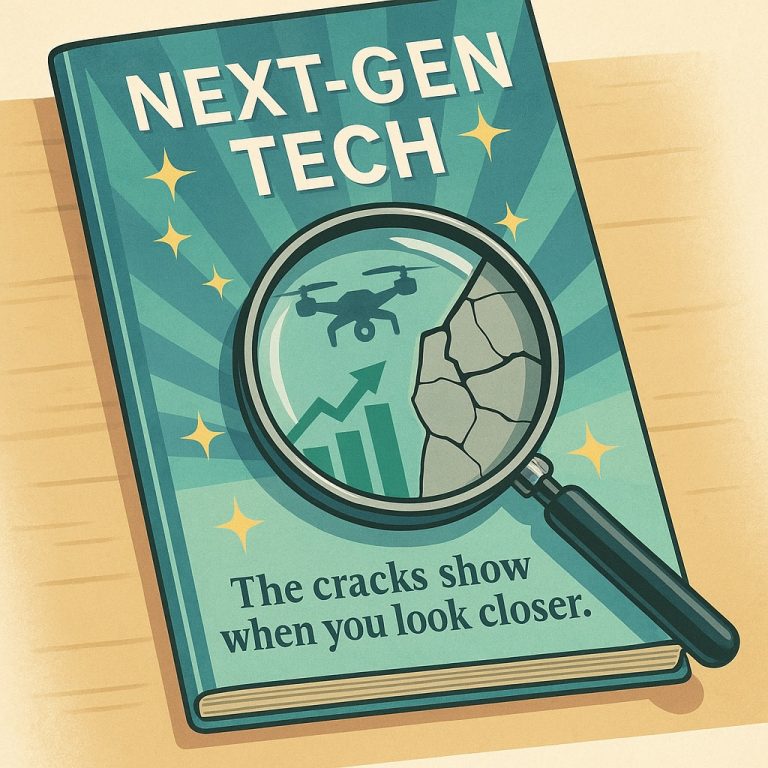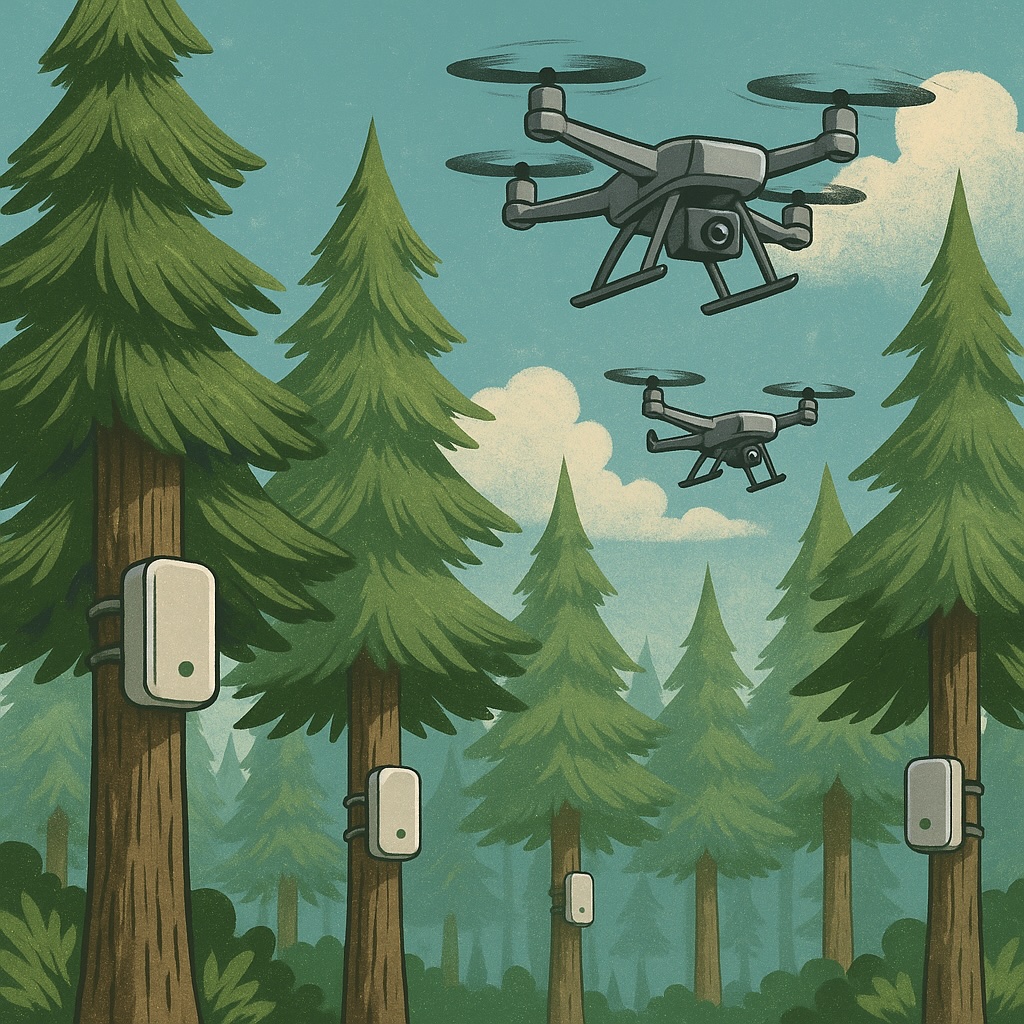When Minutes Mean Everything
In wildfire detection, minutes aren’t just minutes — they’re survival margins. Under hot, dry, windy conditions, a spark can explode into a wall of flame before most people have time to process what’s happening. In that context, the question isn’t what looks good in a pitch deck. It’s: can the technology keep up with fire?
Over the past few years, we have seen a surge of “next-generation” wildfire detection systems. Some look slick, some sound clever, and a few show promise. But when tested against the realities of fire behaviour, physics, and economics, many fall apart.

One of the most hyped contenders right now? Gas sensors and drones.
On paper, gas sensors sound ingenious: scatter them across a forest, wait for combustion gases like hydrogen or carbon monoxide, then raise the alarm. Drones, meanwhile, promise an airborne cavalry: sleek, autonomous, bristling with sensors, ready to confirm detections or even fight flames.
The reality is harsher. Gas sensors are slow. Drones are fragile. And both buckle under the weight of cost and physics.
Smoke Beats Gas and Heat — Every Time
To understand why, let’s start with the basics of wildfire signals.
- Smoke: As soon as a fire burns, smoke rises. Thermal buoyancy lifts it above the treeline where it can be spotted quickly, often within minutes.
- Heat: Satellites or infrared sensors wait for the fire to grow large enough to stand out from background heat — usually too late.
- Gas: Combustion gases spread sideways, drifting with the wind. They take time — often 20 to 60 minutes — to reach a ground sensor in detectable concentrations.
Dryad Networks, one of the most talked-about gas-sensor companies, admits as much: with sensors spaced 100 metres apart, detection can take up to an hour.
Now put that next to fire behaviour. In plantations or eucalyptus forests, flames can advance kilometres in that same hour. In grasslands, they can sprint 25 kilometres in less than sixty minutes.
By the time a gas sensor sniffs hydrogen, the fire has already consumed a block.
 Smoke plumes detected within minutes of ignition by exci’s AI-powered wildfire detection system through the Rocky Perch Fire Tower
Smoke plumes detected within minutes of ignition by exci’s AI-powered wildfire detection system through the Rocky Perch Fire Tower
Dryad: A Case Study in Over-Promising
Dryad’s “Silvanet” system has won headlines and investor attention. The pitch: solar-powered sensors, scattered through a LoRa mesh, scanning for gases every minute. A small surface fire, they say, can be caught within an hour if it’s inside the 100-metre radius.
But here’s the kicker: one hour is not ultra-early detection. It’s already too late.

And that’s under perfect airflow, flat terrain, and no obstructions. Add real-world complexity — variable winds, different vegetation, or high humidity — and the delays only grow. Worse, the Bosch BME688 sensors Dryad uses aren’t plug-and-play AI devices. They require constant calibration, baseline training, and are notoriously sensitive to environmental noise. Switch from pine forest to eucalyptus? Your false positives go up. Throw in vehicle exhaust or a campfire? Good luck.
Without visual confirmation, these sensors can’t even tell you if it’s a wildfire or someone’s BBQ.
The Bill That Breaks the Model
Of course, hype isn’t just about physics — it’s also about cost.
Dryad recommends 0.7 to 1.0 sensors per hectare in “high-risk” areas. For a 310,000-hectare pine plantation, that’s 217,000 to 310,000 sensors. At around AUD $85 a unit, you’re already looking at $18–26 million in hardware. Add installation (working-at-heights certified, $50/hour labour), plus thousands of mesh and border gateways, and the total lands somewhere between $27–43 million.

And that’s just to get to a 30–60 minute detection window.
Try to shrink detection times to something useful — five minutes — and the geometry gets brutal. You’d need sensors every 8 metres. Costs rocket into the billions, with tens of millions of devices, hundreds of thousands of gateways, and a maintenance nightmare.
At that price, it belongs in science fiction, not firegrounds.
LoRa Mesh Dreams – Forest Realities
Dryad leans heavily on its “patent-pending” multi-hop LoRaWAN mesh network. On paper, it sounds clever: tiny sensors bouncing signals from one to the next until the data finally lands at a gateway. In practice, though, the dream runs headlong into physics.
Multi-hop LoRaWAN isn’t the industry standard. It’s experimental, fragile, and notoriously easy to trip up. Forests don’t play nice with radio signals. Trees, moisture, and terrain scatter and absorb transmissions, producing path loss, shadowing, and multipath fading — the very things wireless engineers dread. Multiple studies on wildfire sensor networks have shown that multi-hop links in forested terrain are fragile and prone to failure (Khonrang, 2023; Pueyo-Centelles et al., 2021; Maurya et al., 2023).
That’s why most industries that use LoRa — agriculture, utilities, smart cities — avoid mesh altogether. They stick with the boring but reliable “star” topology: every device talks directly to a gateway.
Wildfire detection doesn’t leave room for science experiments. In a crisis where minutes mean containment or catastrophe, a fragile mesh isn’t an innovation. It’s a liability.
The Drone Distraction
Drones have become the darling of tech brochures — sleek quadcopters in glossy photos, solar-powered hangars waiting to deploy at the push of a button, promises of “autonomous wildfire response.” Dryad calls theirs the Silvaguard (De Cristofaro, 2025; Business Wire, 2025).
The reality? It’s a lithium-powered quadcopter with hobby-grade endurance. Twenty to thirty minutes in real firefighting conditions, then back for charging (FireSafeWorld, 2024). Yes, some enterprise drones boast close to an hour on spec sheets (Measure USA, 2024). But even DJI’s own specifications note these figures are measured with no payload in windless conditions (DJI, 2022; 2023). In smoke, wind, and heat, endurance shrinks fast.
Even the rare long-endurance UAVs — powered by hydrogen, hybrid engines, or solar — don’t change the equation. They are expensive, logistically complex, and geared toward defense or communications, not blanket wildfire detection. They may complement fixed detection systems, but they won’t replace them.
The hype doesn’t stop there. Some startups talk up “heavy-lift” drones hauling 300 kilos of payload. The numbers sound impressive until you see the bill: half a million to more than a million dollars per aircraft. Add specialist crews, ground support, and fuel staging, and they start looking less like futuristic robots and more like smaller, fussier helicopters. And like helicopters, they can’t fly freely in active fire zones. Airspace belongs to the water bombers and suppression teams.
And then comes the wildest pitch of all: drones that don’t just watch fires, but fight them — blasting flames with sound waves. In a lab, sure, you can snuff out a candle with a speaker. In the bush? Wind scatters sound, trees absorb it, terrain bends it. To even register against a wildfire’s roar, you’d need 150 decibels — the acoustic punch of a jet engine. That would deafen anyone nearby and devastate wildlife before it dented a fire front.
Drones have their place. They’re good at surveying burns, mapping flare-ups, or confirming a smoke sighting. But as the backbone of wildfire detection or suppression? The physics, the costs, and the safety rules all say the same thing: not today, not at scale, and not for the price tag.
The Cost of Waiting
Even if Dryad’s system works exactly as pitched — and that’s generous — confirmation times still stretch toward an hour. Let’s break it down:
- Ignition → fire starts
- Gas drift → 20–60 minutes to reach a sensor
- Data relay → 1–5 minutes through mesh, gateways, cloud
- Human or automated review → 5–10 minutes
- Drone prep and flight → another 15–30 minutes
- Visual confirmation → only then do you know for sure
Total: ~55–97 minutes.
By that point, in grasslands you are looking at up to 2,000 hectares burned. In plantations, whole blocks could be lost. That is billions in timber value, carbon, jobs, and habitat — gone before a single hose has hit the fire.
Proven vs. Promised – exci.ai
Take away the hype and it boils down to this:
- Gas sensors can’t outrun physics.
- Mesh networks trip over themselves.
- Drones drain their batteries before they do any good.
- And “acoustic suppression”? Fun in a lab demo, useless in a bushfire.
That’s the promised technology.
The proven technology is exci.ai.
Through years of archiving and curating imagery from more than 1,000 cameras, exci has built one of the most extensive — if not the most extensive — annotated datasets for wildfire detection. That dataset powers our AI, which has already picked up more than 180,000 wildfires across Australia and North America.
The result? Smoke spotted within minutes, even in rugged terrain, and false alarms kept to near-zero.
And while sensor networks need hundreds of thousands of units, exci can cover hundreds of square kilometres with a single camera. Our system links straight to cameras on towers. In remote areas, solar panels, Starlink, and microwave links keep them online. And because we are a lean, family-run company — not one chasing investor returns — we can deliver fire protection at a fair cost, without the bloat.
Most importantly, it’s Australian-made and Australian-owned — no foreign investors pulling strings, no tariffs, no data disappearing overseas.
The Bottom Line
In wildfire detection, the clock doesn’t care about hype. It only rewards speed, reliability, and scalability. Gas sensors stall, drones falter, and “lab tricks” stay in the lab. exci delivers in the field.
We are not promising what might work one day. We are delivering what works now — protecting over 40 million acres today.
Because in the race against wildfire, if it doesn’t work in the field, it doesn’t work at all.
📄 Want the Full Technical Analysis?
We have published a detailed white paper with full cost modelling, references, and technical analysis too.
👉 Request the White Paper
Send us a quick note at whitepaper@exci.ai with your name and we will email you the PDF directly.
by Gabrielle Tylor
exci AI Bushfire & Wildfire Detection in Minutes
Smoke Alarm for the Bush
28 August 2025

